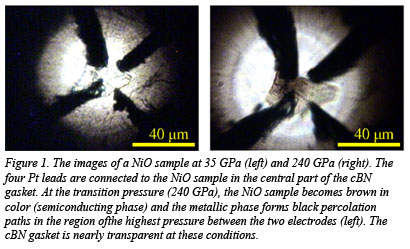For decades, physicists have predicted that the nickel oxide would transition from an insulator to a metal under compression, but their predictions had not been confirmed until now. Carnegie scientist Viktor Struzhkin and colleagues from the Russian Academy of Sciences have discovered the conditions under which nickel oxide can turn into an electricity-conducting metal. Identifying the transition has been a major goal of condensed matter physics for many decades.  Nickel oxide is one of the first compounds to be studied for its electronic properties, but until now scientists have not been able to induce a metallic state. The compound becomes metallic at enormous pressures of 2.4 million times the atmospheric pressure (240 gigapascals). The finding is published in the XX issue of Physical Review Letters.
Nickel oxide is one of the first compounds to be studied for its electronic properties, but until now scientists have not been able to induce a metallic state. The compound becomes metallic at enormous pressures of 2.4 million times the atmospheric pressure (240 gigapascals). The finding is published in the XX issue of Physical Review Letters.
Nickel oxide is a transition metal oxide, which despite its partially filled outer shell of electrons, remains an insulator.  The scientists placed 1µ thick crystal samples into a custom-designed diamond anvil cell. Four thin foil leads were crafted to allow the measurements. The researchers were able to measure declining electronic resistance beginning at 130 GPa. 240 GPa there was a dramatic, three-order-of-magnitude drop in electronic resistance indicating a change from a semiconducting to a metallic state. The metallic part of the material was located in the region of highest compression [A. Gavriliuk et al., Phys. Rev. Lett 109, 086402 (2012)].
The scientists placed 1µ thick crystal samples into a custom-designed diamond anvil cell. Four thin foil leads were crafted to allow the measurements. The researchers were able to measure declining electronic resistance beginning at 130 GPa. 240 GPa there was a dramatic, three-order-of-magnitude drop in electronic resistance indicating a change from a semiconducting to a metallic state. The metallic part of the material was located in the region of highest compression [A. Gavriliuk et al., Phys. Rev. Lett 109, 086402 (2012)].
